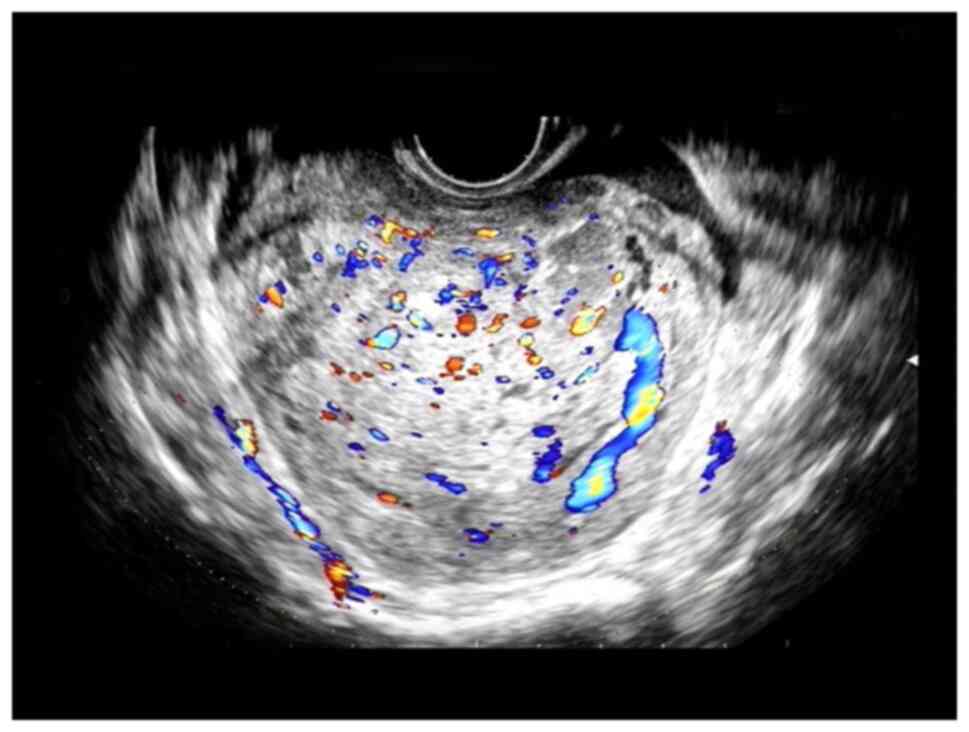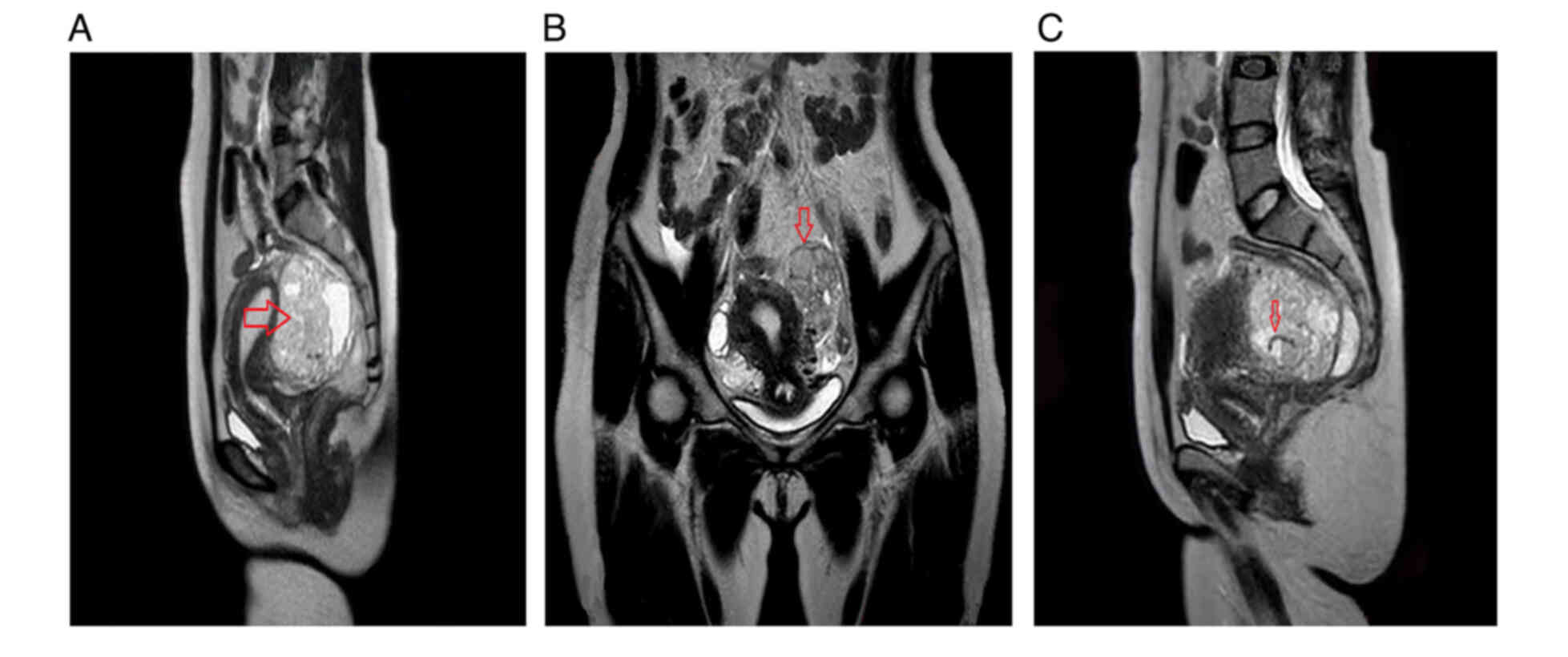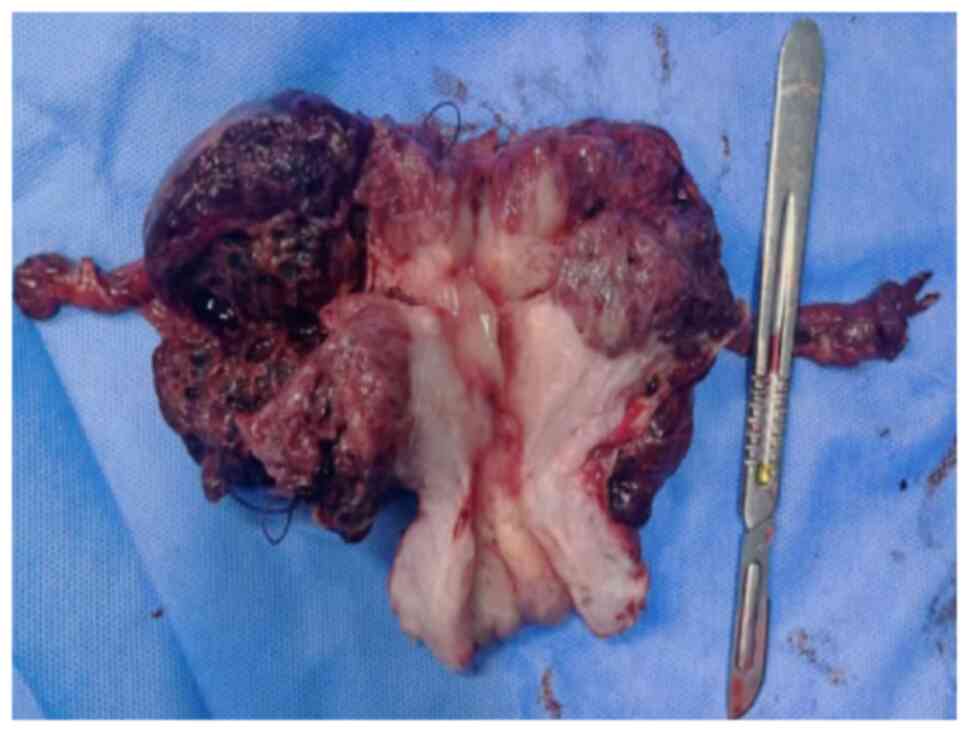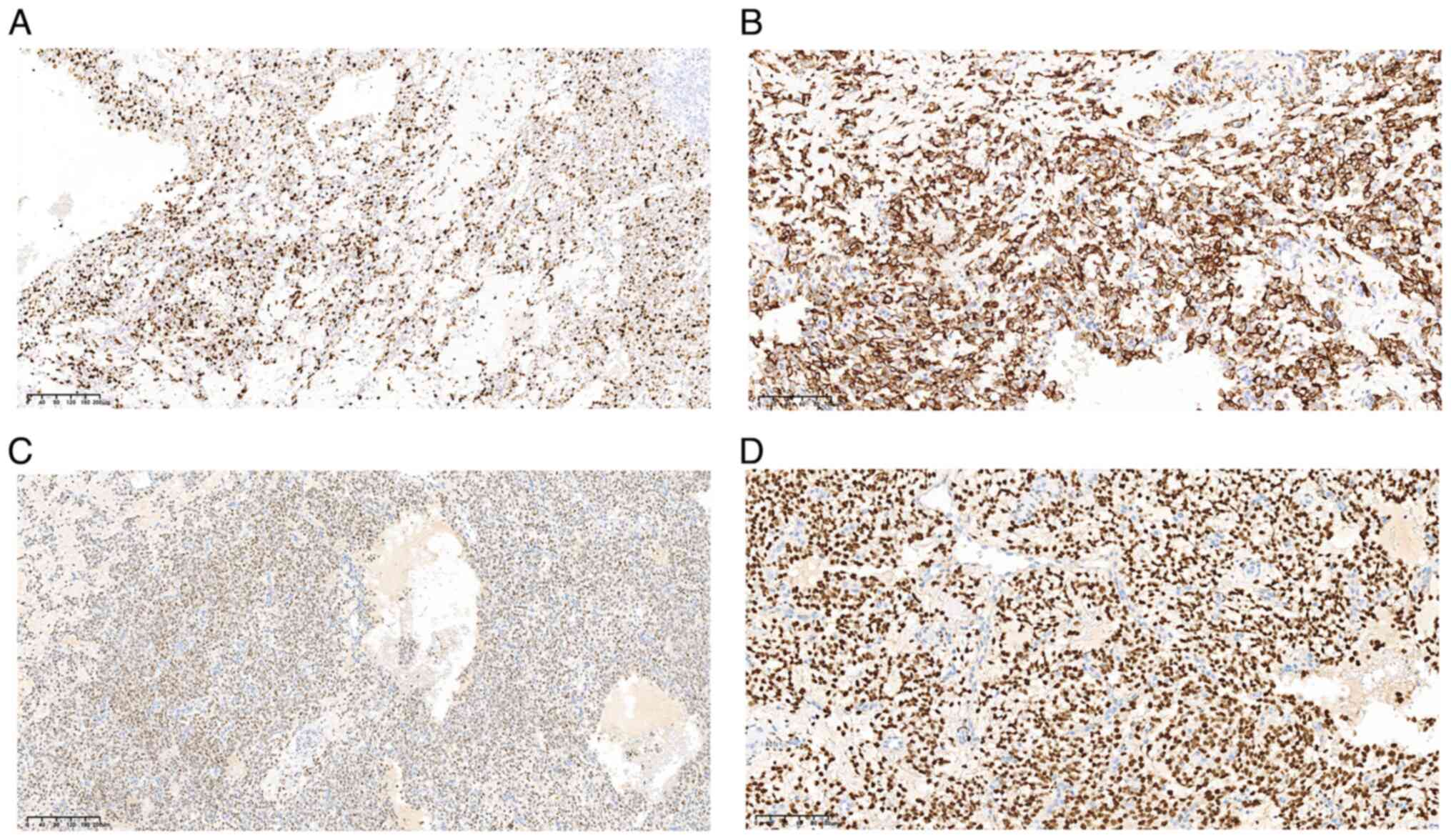Myxoid leiomyosarcoma of the uterus in a woman of childbearing age: A case report
- Authors:
- Published online on: April 2, 2025 https://doi.org/10.3892/ol.2025.15010
- Article Number: 264
-
Copyright: © Wang et al. This is an open access article distributed under the terms of Creative Commons Attribution License.
Abstract
Introduction
Uterine leiomyosarcoma (uLMS) is a type of interstitial malignant tumor that originates from the smooth muscle of the uterus, accounting for 40–50% of all cases of uterine sarcoma and 1–2% of all malignant tumors of the uterine body (1). Histopathological subtypes of uLMS include the spindle cell type, which is the most common, the epithelioid type and the mucous type (2). Uterine myxoid leiomyosarcoma (MLMS) is an extremely rare, aggressive variant of uLMS, with an annual incidence of 0.64 cases per 100,000 women (3). This disease primarily affects perimenopausal women and is uncommon in women of childbearing age and has an unfavorable evolution and prognosis (4). Due to its non-specific clinical presentation and lack of distinctive findings in preoperative auxiliary examinations, Early uterine sarcomas are often misdiagnosed as benign uterine disease. Therefore, early diagnosis and timely intervention of MLMS are challenging, which can lead to considerable psychological and physical distress for patients. In the present case report, a rare case of MLMS in a woman of reproductive age is described, and details of its clinical presentation, diagnosis and treatment are presented.
Case report
A 33-year-old female presented to the Women and Children's Hospital Affiliated to Ningbo University (Ningbo, China) in February 2024 with lower abdominal pain. Ultrasonography revealed an unevenly echogenic region measuring 94×74×88 mm in the posterior wall myometrial layer, which was predominantly cystic in nature. Uterine echogenicity was heterogeneous, with a bilateral endometrial thickness of 13 mm. A three-dimensional scan of the uterine cavity displayed an inverse triangle shape. Furthermore, a dark cystic region measuring 76×58×71 mm was identified in the left ovary, exhibiting a fine internal mesh structure. No abnormalities were evident in the right adnexal region, and color Doppler flow imaging (CDFI) revealed no abnormal blood flow signals. The patient denied any history of hormone drug use, prior surgery or a family history of tumors.
In February 2024, the patient went to the Gynecology Department of the Affiliated Women and Children's Hospital of Ningbo University (Ningbo, China), where a three-dimensional follow-up ultrasound examination revealed a region of uneven echogenicity in the posterior wall of the uterus exhibited measuring 120×62×109 mm, with unclear boundaries and cystic components. CDFI indicated abundant blood flow signals (Fig. 1), which suggested cystic degeneration of uterine myoma. Magnetic resonance imaging (MRI) indicated the presence of subserous fibroids in the posterior wall of the uterus, along with degenerative cystic masses in the bilateral adnexal area and broad ligament fibroids, which warranted further investigation (Fig. 2). Preoperative examination of tumor markers, including cancer antigen 125 (CA125), a-fetoprotein (AFP), carbohydrate antigen 19–9, carcinoembryonic antigen and human epididymis protein 4, yielded negative results. Subsequently, laparoscopic exploration, pelvic lymph node biopsy and posterior uterine wall biopsy were performed. Pathological examination of the frozen section obtained during surgery revealed that the posterior wall of the uterus was occupied by tumor cells exhibiting diffuse growth, abundant cytoplasm and visible mitotic activity. Tumor cells were also identified in the left external iliac lymph node and the right obturator lymph node, both of were indicative of metastatic involvement. The surgical procedure included exploratory laparotomy, total hysterectomy and bilateral salpingectomy, with preservation of the ovaries (Fig. 3). The patient was discharged from the hospital 6 days post-surgery.
The final pathological report confirmed that the posterior wall of the uterus was occupied by a mesenchymal malignant tumor, identified as MLMS, as corroborated by immunohistochemical findings (Fig. 4). The tumor measured 70×50×45 mm and had infiltrated the outer serous membrane. Notably, no tumor involvement was observed on either side of the uterus. However, tumor involvement was detected in the extracapsular fibrous adipose tissue of a left external iliac lymph node. Two right obturator lymph nodes were assessed: One showed tumor involvement while the other exhibited involvement of its extrinsic fibrous adipose tissue. Immunohistochemistry was performed to assist in diagnosis. Tissue was immersed in 10% neutral formalin at room temperature for >20 h, after which it was embedded in paraffin blocks. The paraffin blocks were sectioned to a thickness of 4 µm and baked at 60°C for 30–60 min. Paraffin sections were immersed in fresh xylene and descending ethanol solutions. The tissue was then rinsed with tap water and PBS and heated to 100°C. Following treatment with 3% H2O2 for 10 min at room temperature, 10% normal goat serum (Scientific Phygene) was added at 37°C for 30 min to block nonspecific binding. Primary antibodies against Ki-67 (dilution 1:800; cat. no. ZM-0165 Beijng Zhongshan Golden Bridge), ER (Ready to use; cat. no. 790-4324; Roche), PR (Ready to use; cat. no. 790-4296; Roche) and Desmin (dilution 1:200; cat. no. M0760; DAKO) were added and incubated at 37°C for 2 h. The samples were then washed 3 times with PBS (2 min). Subsequently, added horseradish peroxidase (HRP)-labeled as the secondary antibody (dilution 1:200; cat. no. K4001; DAKO) and incubated at 37°C for 30 min. The samples were washed again 3 times with PBS with each wash lasting 2 min. A volume of 10 µl freshly prepared DAB solution was added, samples were rinsed with tap water and counterstained with hematoxylin for 30–60 sec at room temperature, followed by rinsing with tap water to restore the blue color. The samples were dehydrated by using ethanol gradients. Sections were treated with xylene 3 times for 2 min each to achieve transparency. Finally, the sections were sealed with neutral gum and observed under a light microscope (Olympus Corporation). Immunohistochemical analysis revealed Ki-67 (+50%), pan-cytokeratin (CK) (−), cell adhesion molecule 5.2 (−), CK7 (−), estrogen receptor (clonal number SP1) (+), progesterone receptor (clonal number 1E2) (+), CD10 (−), cyclin D1 (−), desmin (+), smooth muscle actin (SMA) (−), caldesmon (−), Melan-A (A103) (−), human melanoma black 45 (−), calretinin (−), CK5/6 (−), D2-40 (−), Wilms tumor (+), Ets-related gene (−), CD31 (−), ALK (clone D5F3) (−), myogenic differentiation 1 (−), myogenin (−), Sal-like 4 (−), Octamer-binding transcription factor ¾ (−), AFP (−), S-100 (−), SRY-box-10 (−), CD56 (+), inhibin A (−), P53 (clone number DO-7) (normal coloring); BCL6 corepressor (−) and actin (−) (Fig. 5). Based on the staging and classification of uterine sarcoma according to the 2009 International Federation of Gynecology and Obstetrics guidelines (5), a diagnosis of MLMS (stage IIIC) was established.
At 3 weeks post-surgery, the patient underwent positron emission tomography/computed tomography for further evaluation. The results indicated a high likelihood of vaginal stump inflammation, a right paravascular cystic lesion, physiological changes in the bilateral accessory area, and a small amount of pelvic effusion. In April 2024, laparoscopic bilateral oophorectomy, decompression of pelvic adhesions, appendectomy and greater omental biopsy were performed. Pathological findings were chronic appendicitis, degeneration and old hemorrhage in the left ovarian tissue, and corpus luteum hemorrhage in the right ovarian tissue. In addition, pathological findings from the greater omentum biopsy showed fibrous adipose tissue with a cystic follicular structure. The GD regimen, comprising gemcitabine 1.4 g on day 1 and 1.3 g day 8 and docetaxel 100 mg on day 8 was administered after surgery. As of March 2025, the patient had received six cycles of GD. Follow-up is performed every 3 months and the patient is in good condition with no obvious complications or signs of recurrence.
Discussion
MLMS is a very rare histological subtype of uLMS, which is highly invasive, prone to recurrence and has a poor prognosis (6,7). LMS predominantly affects patients between 50 and 55 years old, with only 15% of cases occurring in individuals <40 years old (8). The present case report describes a 33-year-old female of reproductive age who was diagnosed with MLMS, a very rare clinical finding. Analysis of this case may improve the awareness and recognition of MLMS in women of childbearing age, thereby improving the prospects for early diagnosis and individualized treatment and ultimately protecting female fertility.
The clinical manifestations of MLMS include abnormal uterine bleeding (56%), palpable pelvic mass (54%) and/or pelvic pain (21%) (9). In the present case, the patient presented with lower abdominal pain, and both MRI and three-dimensional ultrasound suggested the possibility of uterine fibroids; however, these findings lack specificity in the diagnosis of MLMS. The clinical and imaging manifestations of MLMS are challenging to distinguish from those of benign uterine fibroids, and ultrasound lacks diagnostic specificity in distinguishing between the two (10). The CA125 tumor marker has been proposed as a potential indicator for MLMS, but its clinical significance remains unclear (11,12). This underscores the challenges in the preoperative diagnosis of MLMS (9). Therefore, the histopathological examination of surgical specimens is essential for the accurate diagnosis of MLMS (13). At present, the histopathological diagnosis of MLMS is mainly based on hematoxylin and eosin staining, with the microscopic observation of tumor cell necrosis, nuclear pleomorphism, a mitotic rate of ≥0.4/mm2, equivalent to ≥1/10 high-power fields, and mitotic changes (4,14). Furthermore, in a previous case, immunohistochemical analysis revealed α-SMA, desmin and vimentin positivity (15). MLMS is characterized by a soft, gelatinous consistency and rich mucoid matrix, which distinguishes it from other types of tumors. Therefore, in young women with a history of uterine fibroids and pelvic symptoms, the presence of visible soft tissue, microscopic mitosis, cellular polymorphism, a mucus-rich composition and specific immunohistochemical markers lay a foundation for the diagnosis of MLMS.
MLMS in women of childbearing age is often misdiagnosed as benign fibroids. In a previous case report, a 26-year-old woman who underwent myomectomy for uterine fibroids was initially diagnosed with a borderline/low-grade mucinous mesenchymal-derived tumor (16). However, after 4 years of postoperative follow-up, multiple soft tissue masses were found in the pelvis, leading to the suspicion of recurrent MLMS. Therefore, total hysterectomy and bilateral adnexectomy were performed; misdiagnosis led to the permanent loss of fertility in this patient. For patients of childbearing age diagnosed with uterine fibroids prior to surgery, laparoscopic myomectomy offers several benefits over abdominal myomectomy. These include reduced blood loss, a shorter hospital stay, and reduced postoperative analgesia requirements, without a significant increase in the incidence of complications. In addition, obstetric outcomes are comparable between the two approaches (17). Considering the medical history of the present case, after the patient had completed a fertility plan, the imaging results were carefully evaluated, and comprehensive discussions were held between the medical team and the patient regarding surgical approach, safety and fertility considerations. A decision was made to perform transabdominal surgery, based on the risk of postoperative uterine sarcoma. However, intraoperative frozen section analysis revealed a malignant tumor. Since the patient was young, bilateral ovaries were originally preserved, while a total hysterectomy and bilateral salpingectomy were performed. However, the final postoperative pathology led to a diagnosis of MLMS, leading to a subsequent bilateral ovariectomy. This highlights the importance of individualized treatment plans tailored to the specific patient.
At present, the main treatment method for MLMS is surgical intervention. However, postoperative adjuvant therapy, including radiotherapy, chemotherapy, targeted therapy and immunotherapy, also play a key role (18). There is no standardized treatment plan for MLMS, and the effectiveness of adjuvant therapy remains unclear, with most drugs still undergoing clinical trials. Although no specific targeted therapies or immunotherapies for MLMS are available, molecular and protein-level analyses can be helpful in the identification of patients at risk of relapse (19). Research on immune checkpoint inhibitors and targeted therapies is ongoing, with the aim of determining effective treatment methods and ultimately improving patient prognosis and survival rates. In the present case, no recurrence occurred in the first 6 months after surgery.
MLMS is a rare pathological type of uterine sarcoma, and uterine sarcoma is often misdiagnosed as uterine fibroids, which are more common in women of reproductive age. The low incidence of MLMS in this age group can lead to delays in its diagnosis. Sensitive indices to determine the nature of hematological tumors are currently lacking. Therefore, it is crucial to identify specific markers for uterine sarcoma in women of childbearing age. In the present case, blood indicators and imaging findings were not sensitive in determining the nature of the tumor. In such rare cases, a multidisciplinary approach involving obstetrics and gynecology, imaging, oncology and clinical laboratory medicine are necessary. Multidisciplinary discussions are essential in the diagnosis and treatment of rare diseases. Strengthening the early diagnosis and long-term management of MLMS in women of childbearing age is particularly important. However, it must be noted that the present discussion is based on a single case. Future studies with additional cases are necessary to further investigate MLMS, provide insights into its early diagnosis, and ultimately improve patient outcomes and survival rates.
In conclusion, MLMS is a rare malignant tumor of the uterus. In the present case, a 33-year-old patient with MLMS presented with symptoms similar to those of benign uterine fibroids, highlighting the challenges of early diagnosis, particularly in women of reproductive age. The present case report aims to serve as a reference for the early diagnosis and individualized treatment of MLMS, as well as to encourage further research into this disease.
Acknowledgements
Not applicable.
Funding
Funding: No funding was received.
Availability of data and materials
The data generated in the present study may be requested from the corresponding author.
Authors' contributions
TW, XW, JW, XL and LP contributed to study conception and design. XW, JW, XL and LP analyzed data. TW wrote the manuscript and all authors commented on the manuscript. TW and XW confirm the authenticity of all the raw data. All authors read and approved the final version of the manuscript.
Ethics approval and consent to participate
Not applicable.
Patient consent for publication
Written informed consent was obtained from the patient for the publication of this case report and the accompanying images.
Competing interests
The authors declare that they have no competing interests.
Glossary
Abbreviations
Abbreviations:
|
AFP |
α-fetoprotein |
|
CA125 |
cancer antigen 125 |
|
CDFI |
color Doppler flow imaging |
|
MLMS |
uterine myxoid leiomyosarcoma |
|
MRI |
magnetic resonance imaging |
|
uLMS |
uterine leiomyosarcoma |
References
|
Mbatani N, Olawaiye AB and Prat J: Uterine sarcomas. Int J Gynaecol Obstet. 143 (Suppl):S51–S58. 2018. View Article : Google Scholar | |
|
Chinese Anticancer Association Gynecological Tumor Professional Committee, . Diagnosis of uterine sarcoma in treatment guidelines (2021 edition). China Oncology. 31:513–519. 2021.(In Chinese). | |
|
Harlow BL, Weiss NS and Lofton S: The epidemiology of sarcomas of the uterus. J Natl Cancer Inst. 76:399–402. 1986.PubMed/NCBI | |
|
Istrate-Ofiţeru AM, Zorilă GL, Ruican D, Petrescu AM, Berbecaru EIA, Roşu GC, Căpitănescu RG, Nagy RD, Cercelaru L, Edu A, et al: Uterine myxoid leiomyosarcoma-A rare malignant tumor: The role of complex morphopathological assay. Review and case presentation. Rom J Morphol Embryol. 62:883–896. 2021. View Article : Google Scholar : PubMed/NCBI | |
|
Sen A; FIGO, : FIGO 2009 classification for uterine sarcoma staging: FIGO 2023 endometrial cancer classification for carcinosarcoma staging. Int J Gynaecol Obstet. 167:12732024. View Article : Google Scholar : PubMed/NCBI | |
|
Ng WK, Lui PCW and Ma L: Peritoneal washing cytology findings of disseminated myxoid leiomyosarcoma of uterus: Report of a case with emphasis on possible differential diagnosis. Diagn Cytopathol. 27:47–52. 2002. View Article : Google Scholar : PubMed/NCBI | |
|
Takano Y, Morimura Y, Yamada H, Yanagida K, Sato A, Suzuki O and Suzuki T: Myxoid leiomyosarcoma of the uterus. Fukushima J Med Sci. 46:41–47. 2000. View Article : Google Scholar : PubMed/NCBI | |
|
Gadducci A, Landoni F, Sartori E, Zola P, Maggino T, Lissoni A, Bazzurini L, Arisio R, Romagnolo C and Cristofani R: Uterine leiomyosarcoma: Analysis of treatment failures and survival. Gynecol Oncol. 62:25–32. 1996. View Article : Google Scholar : PubMed/NCBI | |
|
Cui RR, Wright JD and Hou JY: Uterine leiomyosarcoma: A review of recent advances in molecular biology, clinical management and outcome. BJOG. 124:1028–1037. 2017. View Article : Google Scholar : PubMed/NCBI | |
|
Antonio R, Dieg R and Daniele N: Diagnostic accuracy of ultrasound in the diagnosis of uterine leiomyomas and sarcomas. J Minim Invasive Gynecol. 31:28–36. 2024. View Article : Google Scholar : PubMed/NCBI | |
|
Kagami S, Kashimura M, Toki N and Katuhata Y: Myxoid leiomyosarcoma of the uterus with subsequent pregnancy and delivery. Gynecol Oncol. 85:538–542. 2002. View Article : Google Scholar : PubMed/NCBI | |
|
Mittal K, Popiolek D and Demopoulos RI: Uterine myxoid leiomyosarcoma within a leiomyoma. Hum Pathol. 31:398–400. 2000. View Article : Google Scholar : PubMed/NCBI | |
|
Wankhade R, Sajjanar A, Dawande P and Noman O: A rare case of uterine myxoid leiomyosarcoma. Cureus. 15:e443032023.PubMed/NCBI | |
|
Burch DM and Tavassoli FA: Myxoid leiomyosarcoma of the uterus. Histopathology. 59:1144–1155. 2011. View Article : Google Scholar : PubMed/NCBI | |
|
Wang Y, Teng Y, Na S and Yuan Y: Pleomorphic leiomyosarcoma of the adrenal gland in a young woman: A case report and review of the literature. Onco Targets Ther. 13:4705–4713. 2020. View Article : Google Scholar : PubMed/NCBI | |
|
Li RP, Zhang M, Gao J and Guo Y: Misdiagnosis and mistreatment of uterine myxoid leiomyosarcoma: A case report and literature review. Asian J Surg. 46:2714–2715. 2023. View Article : Google Scholar : PubMed/NCBI | |
|
Giannini A, Cuccu I, D'Auge TG, De Angelis E, Laganà AS, Chiantera V, Caserta D, Vitale SG, Muzii L, D'Oria O, et al: The great debate: Surgical outcomes of laparoscopic versus laparotomic myomectomy. A meta-analysis to critically evaluate current evidence and look over the horizon. Eur J Obstet Gynecol Reprod Biol. 297:50–58. 2024. View Article : Google Scholar : PubMed/NCBI | |
|
Berchuck A, Rubin SC, Hoskins WJ, Saigo PE, Pierce VK and Lewis JL: Treatment of uterine leiomyosarcoma. Obstet Gynecol. 71:845–850. 1988.PubMed/NCBI | |
|
Giannini A, Golia D'Augè T, Bogani G, Laganà AS, Chiantera V, Vizza E, Muzii L and Di Donato V: Uterine sarcomas: A critical review of the literature. Eur J Obstet Gynecol Reprod Biol. 287:166–170. 2023. View Article : Google Scholar : PubMed/NCBI |















